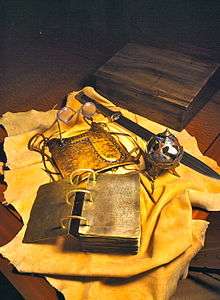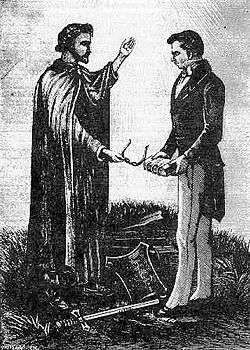Urim and Thummim (Latter Day Saints)

In the Latter Day Saint movement, the Urim and Thummim (/ˈjuːr.ɪm/[1] and /ˈθʌm.ɪm/[2]) (also called Interpreters) usually refers to a set of seer stones bound by silver bows into a set of spectacles, that movement founder Joseph Smith said he found buried in the hill Cumorah with the golden plates.
History
In 1823, Smith said that an angel Moroni told him of the existence, with the plates, of "two stones in silver bows" fastened to a breastplate, which the angel called the Urim and Thummim and which he said God had prepared for translating the plates.[3] Smith's mother, Lucy Mack Smith, described them as crystal-like "two smooth three-cornered diamonds."[4] Oliver Cowdery said the stones were "transparent".[5] Smith and his early Mormon contemporaries seem to have used the terms "seer stone" and "Urim and Thummim" interchangeably.[6] Although Smith always referred to the Book of Mormon "interpreters" as the Urim and Thummim, he may or may not have intended to make a distinction between that device and the seer stones that he used in receiving revelations.[7] The LDS Church has suggested that Smith and his contemporaries "seem to have understood the term more as a descriptive category of instruments for obtaining divine revelations and less as the name of a specific instrument".[6]

In 1827, Smith said that he had been visited again by the angel who had previously revealed the location of the golden plates, along with other items such as the Urim and Thummim, and that these objects were buried in a nearby hillside. Smith said that after translating the Book of Mormon, he returned the plates and the Urim and Thummim to the angel, whom he identified as the resurrected Moroni. Smith reportedly told Orson Pratt that the Lord gave him the Urim and Thummim when he was an inexperienced translator but that as he grew in experience, he no longer needed such assistance.[8]
The LDS Bible Dictionary defines the Urim and Thummim as "an instrument prepared of God to assist man in obtaining revelation from the Lord and in translating languages."[9] In the Book of Mormon, the prophets the Brother of Jared and Mosiah both used devices called "interpreters" to receive revelation for their people, and the Doctrine and Covenants declares that these "interpreters" were the Urim and Thummim.[10]
Beliefs
Latter Day Saints believe that the Urim and Thummim of Joseph Smith and the Book of Mormon were the functional equivalent of the Urim and Thummim mentioned in the Old Testament.[11] It could be speculated that there were three different sets of Urim and Thummim: the one of the Old Testament (Exodus 28:30) and two mentioned in the Book of Mormon (one used by the Jaredites and the other by King Mosiah).[12] Another speculation that has been made is that the one used by Smith is the one originally possessed by the Jaredites.[13][14]
See also
Notes
- ↑ LDS.org: "Book of Mormon Pronunciation Guide" (retrieved 2012-02-25), IPA-ified from «yūr´ĭm»
- ↑ LDS.org: "Book of Mormon Pronunciation Guide" (retrieved 2012-02-25), IPA-ified from «thum´ĭm»
- ↑ Joseph Smith–History 1:34–35.
- ↑ Smith, Lucy Mack (1853). The History of Joseph Smith by His Mother. p. 101.
- ↑ March 1831 letter of A.W.B. [Abram W. Benton], in Evangelical Magazine and Gospel Advocate (April 9, 1831) 2:120. (Concerning the 1830 trial of Smith in South Bainbridge, New York, Benton stated: "Oliver Cowdery, one of the three witnesses to the book, testified under oath, that said Smith found with the plates, from which he translated his book, two transparent stones, resembling glass, set in silver bows. That by looking through these, he was able to read in English, the reformed Egyptian characters, which were engraved on the plates".)
- 1 2 "Book of Mormon Translation", lds.org.
- ↑ Richard Van Wagoner and Steven Walker, "Joseph Smith: 'The Gift of Seeing," Dialogue: A Journal of Mormon Thought 15:2 (Summer 1982): 59–63.
- ↑ "Two Days' Meeting at Brigham City," Millennial Star 36 [1874]:498–99).
- ↑ "Urim and Thummim," Bible Dictionary.
- ↑ D&C 17.
- ↑ There are seven references to the Urim and Thummim in the Masoretic Text (the basis of most English translations of the Old Testament): Exodus 28:30, Leviticus 8:8, Numbers 27:21, Deuteronomy 33:8, 1 Samuel 28:6, Ezra 2:63, Nehemiah 7:65. The Septuagint version (the pre-Christian Greek translation of the Old Testament) and some English translations of 1 Samuel 14:41 also references them.
- ↑ Mosiah 8: 13, 15–17
- ↑ D&C 10:1
- ↑ See Bruce R. McConkie, Mormon Doctrine (Salt Lake City: Bookcraft, 1966), pp. 818–19.
References
- Van Wagoner, Richard S. (Summer 1982), "Joseph Smith: The Gift of Seeing", Dialogue: A Journal of Mormon Thought, 15 (2): 48–68.